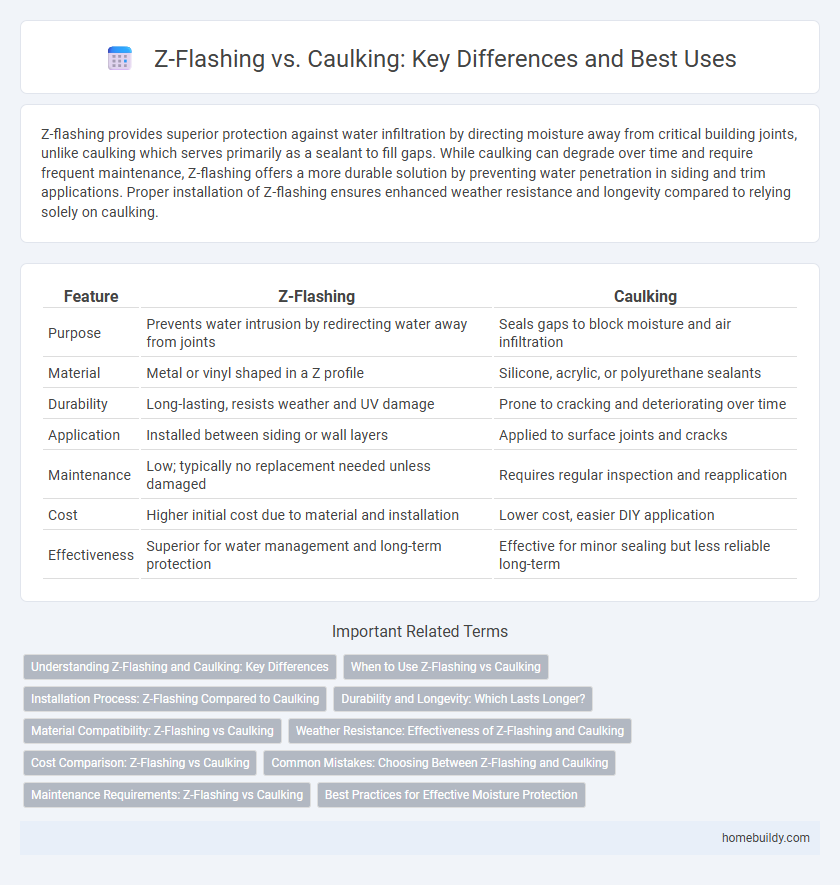Z-flashing provides superior protection against water infiltration by directing moisture away from critical building joints, unlike caulking which serves primarily as a sealant to fill gaps. While caulking can degrade over time and require frequent maintenance, Z-flashing offers a more durable solution by preventing water penetration in siding and trim applications. Proper installation of Z-flashing ensures enhanced weather resistance and longevity compared to relying solely on caulking.
Table of Comparison
| Feature | Z-Flashing | Caulking |
|---|---|---|
| Purpose | Prevents water intrusion by redirecting water away from joints | Seals gaps to block moisture and air infiltration |
| Material | Metal or vinyl shaped in a Z profile | Silicone, acrylic, or polyurethane sealants |
| Durability | Long-lasting, resists weather and UV damage | Prone to cracking and deteriorating over time |
| Application | Installed between siding or wall layers | Applied to surface joints and cracks |
| Maintenance | Low; typically no replacement needed unless damaged | Requires regular inspection and reapplication |
| Cost | Higher initial cost due to material and installation | Lower cost, easier DIY application |
| Effectiveness | Superior for water management and long-term protection | Effective for minor sealing but less reliable long-term |
Understanding Z-Flashing and Caulking: Key Differences
Z-flashing is a metal flashing installed to direct water away from critical areas, providing a durable barrier against moisture intrusion, while caulking is a flexible sealant used to fill gaps and prevent water seepage. Z-flashing is typically made from aluminum or galvanized steel, creating a rigid, long-lasting shield, whereas caulking requires regular maintenance due to its susceptibility to cracking and deterioration. Understanding these differences ensures proper application in construction to enhance waterproofing and prevent structural damage.
When to Use Z-Flashing vs Caulking
Use Z-flashing when installing siding or roofing to create a durable, waterproof barrier that directs water away from vulnerable seams and joints. Caulking is ideal for small gaps, cracks, or joints that require flexible sealing to prevent water infiltration but cannot accommodate flashing. Choose Z-flashing for long-term protection against water penetration in high-exposure areas, while caulking suits minor repairs and maintenance where flashing installation is impractical.
Installation Process: Z-Flashing Compared to Caulking
Z-flashing installation involves securing metal strips above siding or window edges to direct water away, creating a durable barrier against moisture intrusion. Unlike caulking, which requires careful application and regular maintenance to prevent cracks and deterioration, Z-flashing offers a long-lasting solution with less frequent upkeep. Properly installed Z-flashing enhances water resistance and prolongs building envelope integrity in comparison to the more labor-intensive and often less reliable caulking method.
Durability and Longevity: Which Lasts Longer?
Z-flashing offers superior durability compared to caulking by effectively directing water away from vulnerable joints, preventing moisture infiltration that accelerates material degradation. Caulking, while initially sealing gaps, tends to deteriorate faster under UV exposure and temperature fluctuations, requiring frequent maintenance or replacement. Therefore, Z-flashing provides greater longevity and a more reliable moisture barrier in exterior construction applications.
Material Compatibility: Z-Flashing vs Caulking
Z-flashing offers superior material compatibility by creating a physical barrier that prevents water infiltration between different building materials, such as siding and trim, without relying on sealant performance. Unlike caulking, which can degrade or fail over time due to UV exposure and material expansion, Z-flashing remains durable and effective in maintaining a watertight seal. This long-lasting compatibility makes Z-flashing a preferred choice for preventing moisture damage in exterior construction assemblies.
Weather Resistance: Effectiveness of Z-Flashing and Caulking
Z-flashing provides superior weather resistance by directing water away from vulnerable joints, minimizing seepage and preventing structural damage. Caulking offers a flexible seal that fills cracks and gaps but can degrade over time due to UV exposure and temperature fluctuations, reducing its effectiveness. Combining Z-flashing with high-quality caulking enhances overall protection by leveraging the mechanical water diversion of flashing and the sealing properties of caulk.
Cost Comparison: Z-Flashing vs Caulking
Z-flashing typically involves higher upfront material and installation costs compared to caulking but offers greater long-term durability and weather resistance, reducing maintenance expenses. Caulking is less expensive initially but often requires frequent repairs or reapplication due to its susceptibility to cracking and degradation over time. When evaluating cost-effectiveness, Z-flashing provides better value by minimizing ongoing maintenance and potential water damage remediation costs.
Common Mistakes: Choosing Between Z-Flashing and Caulking
Choosing between Z-flashing and caulking often leads to common mistakes, such as underestimating the durability requirements of exterior joints. Z-flashing provides superior water resistance and long-term protection by directing moisture away from vulnerable areas, whereas caulking is prone to cracking and requires frequent maintenance. Misapplication of caulking instead of Z-flashing in critical junctions can result in water infiltration and structural damage.
Maintenance Requirements: Z-Flashing vs Caulking
Z-flashing requires minimal maintenance compared to caulking, as it effectively directs water away and resists deterioration over time. Caulking often demands frequent inspections and reapplications to address cracking, shrinking, or gaps caused by weather exposure. Proper installation of Z-flashing significantly reduces the risk of water infiltration, minimizing long-term maintenance efforts.
Best Practices for Effective Moisture Protection
Z-flashing provides superior moisture protection by directing water away from vulnerable wall joints, making it more effective than caulking in preventing water infiltration. Best practices include installing Z-flashing above windows and doors, ensuring proper overlap with exterior cladding, and sealing all edges to create a continuous barrier. Regular inspection and maintenance of Z-flashing are crucial to preserving its integrity and enhancing the building envelope's durability.
Z-flashing vs caulking Infographic

 homebuildy.com
homebuildy.com